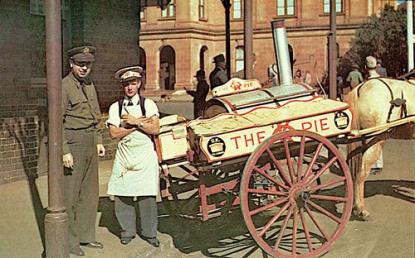
Editor’s Note: A few weeks ago, my husband Mark Roessler wrote a food piece for The Valley Advocate on the meat pies sold at the newish bakery on Main Street, Northampton, Tart. The son of two Australians and someone who has been to Australia and England a number of times and who loves store-bought meat pies, he felt particularly qualified to discuss them. His father David Roessler read the piece and added his own recollections of meat pies sold in Melbourne in the 1950s, posted here. David Roessler lives in Sandgate, Queensland, and is a retired architect with a particular passion for the Australian bungalow.
With meat pies it used to be that Worcestershire Sauce was the goods (called black sauce by some). Here, there were two British brands, Holbrooks and Lea & Perrins, and probably both are still around — L&P is in the supermarket here. Guess you know how to pronounce it: “woosta-sheer.” Or maybe wosta-sheer.
In my student days in Melbourne the condiment of choice was tomato sauce and I’d guess today it remains much the most popular. At a Melbourne football stadium one can buy a pie in a paper bag from a strolling hawker and if you ask for sauce he’ll poke the nose of a big plastic bottle through the top of your pie and squirt a layer of tomato sauce on top of the filling.
In my student days a meat pie made a popular meal and it was always “Pie and Peas” with brown gravy an option. A pie on a plate goes well with green peas — important info here for some! The truly adept can even eat the two by hand while standing.
I’m also reminded of how things were when I was at school in Toowoomba — two big pie companies, OK and Betta, the first being the more popular, I think. Now here’s the interesting bit: they attended all schools every lunchtime and of course sporting events; what you got was a horse-drawn pie-cart that drew up beside the street somewhere near the school or event (always in the same place, of course). They didn’t cost $5, if I remember your Noho [Northampton, MA] price right, but 4 pence (“four-punce”) I think — maybe 6d. Which wasn’t nothing when you could buy a wrapped Nestlé chocolate from a vending machine for a penny.
One horse, a timber cart with two big kid-high wheels with round timber spokes (formed with a spoke-shave) and with steel bindings to meet the road, carrying a steel oven with the pies inside and a small kind of running board at the back for the driver to stand on when moving. And a bottle of sauce attached to the side. (Surprise: they also sold hot apple pies.)
The oven was made from a 44 gallon drum, laid flat with a door facing the driver. Inside, as you’d expect, were flat shelves for the pies and below them, in the lowest part, was a small woodchip fire. (Or was there a firebox below the drum?) Anyway, the crowning glory: top and front was a chimney pipe with smoke giving a fine display and filling the air with the cart’s good news.
[To learn about the “floating pies” of Southern Australia and their conveyances, visit this site, The Pie Cart.]


